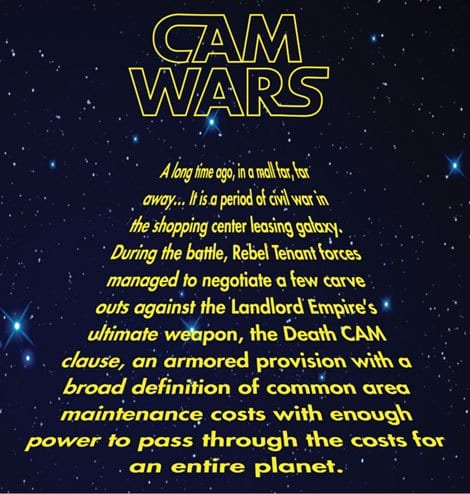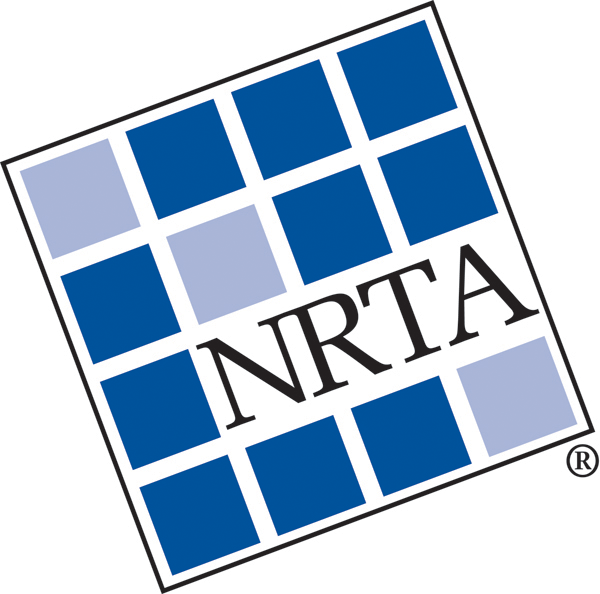CAM WARS
(Part 1 – The Definition of CAM)
by C. Gregg Ankenman, Esq.; Wendel, Rosen, Black & Dean LLP [email protected]

GENERAL DEFINITION OF CAM COSTS.
CAM cost definitions in landlord form retail shopping center leases typically start with a broad, all-encompassing general definition and then, for good measure, throw in a long “including but not limited” list of categories of costs. Over the decades since the shopping center industry first adopted the practice of passing through CAM costs, the scope of what landlords seek to pass through has expanded to the point where most landlord lease forms contain an extremely broad definition of CAM costs that goes far beyond what “common area maintenance” on its face might suggest. For example, landlords’ definitions now frequently go well beyond “maintenance” to expressly include operation, management and other ownership costs. Furthermore, it is typical in a landlord’s lease form for the definition to include more than the costs related to the actual “common areas” sometimes up to the entire shopping center. The more a tenant can do to limit how far the definition goes beyond “maintenance” and the common areas, the better the tenant’s chances are of controlling CAM costs.
EXCLUSIONS FROM CAM COSTS.
Retail tenants often seek to negotiate exclusions and limitations with respect to what landlords may include in the CAM costs passed through to the tenant. As noted above, the outcome of these negotiations will vary depending on a number of factors, including applicable market conditions and relative bargaining power of the parties. Here are some of the key exclusions and limitations tenant should consider in this process.
• Capital expenditures. There are two main issues with respect to capital expenditures: (1) whether all, none or certain categories of capital expenditures should be allowed as CAM costs; and (2) to the extent allowed, whether a capital expenditure should be included in its entirety or whether it should be amortized. Ideally, a tenant wants to fully exclude capital expenditures while landlords would prefer to pass them through entirely in the year they are incurred. Tenants usually can at least negotiate that capital expenditures must be amortized over their useful life. Some tenants are also able to limit capital expenditures allowed in CAM costs to a specified list (e.g., costs to comply with laws, cost-savings items and parking lot repaving).
• Compliance with laws. Tenants should seek to limit these pass-throughs to those improvements required due to newly enacted legal requirements as opposed to pre-existing requirements with which the landlord has failed to comply. When included, these cost should be amortized over the useful life of the improvement in question as noted above.
• Hazardous materials. Tenants should resist inclusion of costs related to hazardous materials. These costs can be substantial, and from a tenant’s perspective, these cost should be a risk of owning real estate not a risk of leasing a store space or building. Of course, tenants undoubtedly will have to accept responsibility for hazardous materials they introduce but should avoid or limit responsibility for other hazardous materials. Compromises sometimes include a specific annual cap on hazardous materials costs or allowing only costs for minor surface clean-up of oils leaks from cars and the like.
• Correction of construction defects. Tenants generally feel they should not bear the cost of correcting construction defects in original construction of the center or in subsequent work by the landlord. Landlords are often willing to give some relief. However, in an older building, particularly where the current landlord was not the original developer, the landlord may be hesitant to invite an argument about what constitutes been a construction defect that occurred many years before.
• Replacements versus additions or upgrades. Tenants with sufficient bargaining power may push to exclude costs of replacements (as opposed to repairs). Even if replacements are allowed, the tenant should attempt to distinguish and exclude additions or upgrades as opposed to replacements of items that have worn out (and been replaced with comparable items). For example, if the landlord determines to replace common area vinyl flooring with marble, that should be treated as an excluded upgrade.
• No double dipping. Landlords should not be able to recover the same cost twice or to recover more than 100 percent of the actual costs. For example, costs charged to the tenant under any other sections of the lease, costs paid by other tenants (other than as their proportionate share of CAM costs) and costs covered by insurance or condemnation proceeds should not be part of CAM costs.
• Reserves. Since costs are being passed through as incurred (or appropriately amortized), tenants should push to exclude reserves. In situations when a tenant does not have the bargaining power to exclude reserves, the lease should at least provide that any applicable reserves must be exhausted before the landlord may include the cost of a covered item in CAM charges.
• Credit for income from Common Areas (e.g. parking charges). Sometimes landlords will seek to retain revenue from certain common areas while passing through the costs of maintaining and operating these areas through CAM. A prime example is parking charges. In most cases, tenants should require that the landlord give a credit against CAM costs for any such revenue.
• Promotional and advertising expenses. CAM costs should not include promotional and advertising expenses. If the tenant is required to contribute to these costs, it should be through a separate, negotiated promotional charge–not snuck into the lease as a back door component of CAM.• Payments to related parties. If a landlord uses a related party (an affiliate or company-related entity) to provide services that are part of CAM, the cost should be reasonable and consistent with what a qualified third party provider would charge.• Allocation among different properties. Larger shopping center operators may have staff who provide services for multiple properties. Costs attributable to any such personnel of landlord or an affiliate should be prorated so that the cost is included in CAM only to the extent their time and energies are devoted to the applicable center.• Management or administrative fees. Retail leases frequently provide that a certain administrative fee (often a certain percentage of other costs) will be included in CAM. The lease should make clear that no other management, overhead, supervisory or administrative costs or fees will be included. Tenants should also consider excluding from the administrative fee items that arguably involve no more than the act of writing a check (or making an electronic payment) such as paying insurance premiums, taxes and utilities. • Other Generally Acceptable Exclusions. The following are other exclusions that tenant should seek, if they are not already excluded in the landlord’s lease form. Landlords generally will not resist some exclusion of these items:
- Initial acquisition, development, and construction costs.
- Mortgage payments and ground lease rents.
- Late charges, interest and penalties on delinquent payments by the landlord.
- Legal fees, leasing commissions, TI costs, etc., in leasing space in the center.
- Costs related specifically to another tenant’s space.
- Landlord’s general business costs not specifically related to the center.
Careful attention to negotiating a fair and reasonable definition of CAM costs in a lease is an important key to controlling CAM costs. The best and most thorough lease administration cannot overcome a poorly crafted definition. When handled with the deftness of a Jedi Master, a Rebel Tenant’s thoughtful negotiation of CAM definitions and clauses can help restore balance to the universe (or at least the lease). May the Force be with you.
